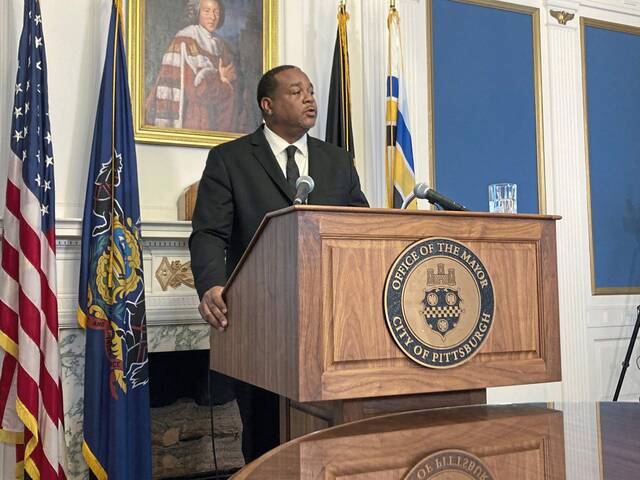https://triblive.com/local/mayor-ed-gainey-releases-preliminary-2023-pittsburgh-budget-with-no-tax-increase/
Mayor Ed Gainey releases preliminary 2023 Pittsburgh budget with no tax increase

Pittsburgh Mayor Ed Gainey on Friday unveiled his first preliminary budget, which does not propose a tax increase.
The $657 million operating budget and $147 capital budget include cash from the American Rescue Plan and aim to fund key areas important to Gainey’s administration, like safe neighborhoods, infrastructure, housing, the environment and economic mobility, the mayor said.
The capital budget includes over $54 million for engineering and construction projects to improve the city’s infrastructure, as well as more than $43 million earmarked for facility improvements.
Gainey announced that his plan calls for a new bridge maintenance division in the Department of Mobility and Infrastructure to conduct day-to-day maintenance for the city’s bridges, as well as a new bridges and structures team to allow for more rapid engineering as bridges need to be rehabilitated or replaced.
Jake Pawlak, director of the Office of Management and Budget, said there is money allocated to respond to infrastructure needs that may be highlighted in a forthcoming report that is expected to outline needed repairs and maintenance for the city’s bridges as part of the mayor’s Bridge Asset Management initiative.
The budget includes a roughly $500,000 increase in the police bureau’s budget.
“The budget does allow for additional staffing within our critical public safety bureaus,” Pawlak said.
Funding allocated to the Department of Public Safety will also pay for six new paramedics, upgrades to in-vehicle and body-worn cameras for police, new swift water rescue equipment, new radios for all public safety departments and a feasibility study to explore a city-owned animal shelter. The budget also continues to fund social work and community health programs, Gainey said.
An additional $4 million allocated to the Department of Public Works will aim to improve staffing and equipment so the city can better respond to snow events and tackle other backlogged projects, Gainey said.
There will also be a phased increase in funding for the Housing Opportunity Fund, Gainey said, as well as a new walls and slopes division to focus on landslides as severe weather has exacerbated such issues.
The budget calls for over $86,000 to offer paid internships to Pittsburgh Public Schools students, as well as funding to hire additional talent recruiters to seek out employees for the city and to expand the zoning and development staff to accelerate reviews.
“I believe that the budget we introduced today helps us become the safest city in America, a city where everyone is welcome, and a city where everyone who lives here and works here can thrive,” Gainey said.
While Gainey touted his budget as a way to advance many of his goals for the city, he acknowledged that it will not cover everything he hopes to accomplish.
“We can’t expect to achieve the entirety of our vision in our first budget,” he said. “This is going to take years.”
In releasing his budget, Gainey also announced changes to where some city functions are housed within city government.
The 311 nonemergency line will move to the Mayor’s Office, Gainey said, in response to concerns from residents that their voices were not heard. It will combine with the Office of Neighborhood Services, housed in the Mayor’s Office.
The Office of Communications, which also is within the Mayor’s Office, will combine with the City Channel, web and print shop teams, which are currently part of the Department of Innovation and Performance. Other communications staff distributed through city departments will join into one city-wide communications team.
Pawlak said his office worked to ensure the budget would be balanced but “as aggressive as possible” in providing for residents.
“The city of Pittsburgh is in a strong financial position,” he said, despite “temporary” financial challenges presented by the covid-19pandemic.
Revenue recovery is “very strong,” he said, though the city is still relying on money from the American Rescue Plan to balance the operating budget.
Pawlak said his office has forecasted that the city will be able to maintain a balanced budget over at least the next five years, even after American Rescue Plan money is gone.
“We really are aware of these challenges, and we’re taking them into account,” he said.
The city is also able to “see the light at the end of the tunnel” in regards to the debt it incurred while in Act 47. Many of those bunds, he said, will finish by 2027, decreasing the city’s debt.
In the 2023 budget, he said, the reserve fund balance will be just under $112 million, or equivalent to about 18% of the city’s operating expenses.
Public engagement for the budget has skyrocketed this year, Gainey said, with a 500% increase in participation in an online survey meant to gauge where the public would like to see money spent. That survey, Gainey said, generated thousands of project ideas and saw participation from residents in 67 of the city’s 90 neighborhoods.
“Infrastructure was the number-one priority,” Gainey said.
The mayor said his office would continue taking public input, and said changes could be made to the budget before it is formally presented to City Council on Nov. 14.
From there, City Council will consider the budget, engage in their own public process, and possibly make tweaks to it before voting on its adoption.
Copyright ©2025— Trib Total Media, LLC (TribLIVE.com)
